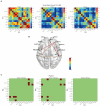The analysis of brain functional connectivity of post-stroke cognitive impairment patients: an fNIRS study
- PMID: 37214384
- PMCID: PMC10196111
- DOI: 10.3389/fnins.2023.1168773
The analysis of brain functional connectivity of post-stroke cognitive impairment patients: an fNIRS study
Abstract
Background: Post-stroke cognitive impairment (PSCI) is a considerable risk factor for developing dementia and reoccurrence of stroke. Understanding the neural mechanisms of cognitive impairment after stroke can facilitate early identification and intervention.
Objectives: Using functional near-infrared spectroscopy (fNRIS), the present study aimed to examine whether resting-state functional connectivity (FC) of brain networks differs in patients with PSCI, patients with Non-PSCI (NPSCI), and healthy controls (HCs), and whether these features could be used for clinical diagnosis of PSCI.
Methods: The present study recruited 16 HCs and 32 post-stroke patients. Based on the diagnostic criteria of PSCI, post-stroke patients were divided to the PSCI or NPSCI group. All participants underwent a 6-min resting-state fNRIS test to measure the hemodynamic responses from regions of interests (ROIs) that were primarily distributed in the prefrontal, somatosensory, and motor cortices.
Results: The results showed that, when compared to the HC group, the PSCI group exhibited significantly decreased interhemispheric FC and intra-right hemispheric FC. ROI analyses showed significantly decreased FC among the regions of somatosensory cortex, dorsolateral prefrontal cortex, and medial prefrontal cortex for the PSCI group than for the HC group. However, no significant difference was found in the FC between the PSCI and the NPSCI groups.
Conclusion: Our findings provide evidence for compromised interhemispheric and intra-right hemispheric functional connectivity in patients with PSCI, suggesting that fNIRS is a promising approach to investigate the effects of stroke on functional connectivity of brain networks.
Keywords: assessment; functional connectivity; functional near-infrared spectroscopy; post-stroke cognitive impairment; stroke.
Copyright © 2023 Zou, Yin, Lin and Gong.
Conflict of interest statement
The authors declare that the research was conducted in the absence of any commercial or financial relationships that could be construed as a potential conflict of interest.
Figures



Similar articles
-
Alteration in brain functional connectivity in patients with post-stroke cognitive impairment during memory task: A fNIRS study.J Stroke Cerebrovasc Dis. 2023 Sep;32(9):107280. doi: 10.1016/j.jstrokecerebrovasdis.2023.107280. Epub 2023 Jul 28. J Stroke Cerebrovasc Dis. 2023. PMID: 37517137
-
Important role of the right hemisphere in post-stroke cognitive impairment: a functional near-infrared spectroscopy study.Neurophotonics. 2025 Jan;12(1):015008. doi: 10.1117/1.NPh.12.1.015008. Epub 2025 Feb 17. Neurophotonics. 2025. PMID: 39963120 Free PMC article.
-
Alterations in brain function in patients with post-stroke cognitive impairment: a resting-state functional magnetic resonance imaging study.Front Aging Neurosci. 2025 Feb 19;17:1501082. doi: 10.3389/fnagi.2025.1501082. eCollection 2025. Front Aging Neurosci. 2025. PMID: 40046780 Free PMC article.
-
Effects of moxibustion on cognition and activities of daily living in post-stroke cognitive impairment: A systematic review and meta-analysis of randomized controlled trials.J Nurs Scholarsh. 2023 Mar;55(2):464-476. doi: 10.1111/jnu.12846. Epub 2022 Nov 8. J Nurs Scholarsh. 2023. PMID: 36345735
-
Post-stroke cognitive impairment: exploring molecular mechanisms and omics biomarkers for early identification and intervention.Front Mol Neurosci. 2024 May 23;17:1375973. doi: 10.3389/fnmol.2024.1375973. eCollection 2024. Front Mol Neurosci. 2024. PMID: 38845616 Free PMC article. Review.
Cited by
-
Effectiveness of Yijinjing on cognitive and motor functions in patients with Parkinson's disease: study protocol for a randomized controlled trial.Front Neurol. 2024 Apr 26;15:1357777. doi: 10.3389/fneur.2024.1357777. eCollection 2024. Front Neurol. 2024. PMID: 38737352 Free PMC article.
-
Changes in cortical activation during proprioceptive stimulation and galvanic vestibular stimulation in healthy individuals and individuals with post-stroke balance disorders: A functional near-infrared spectroscopy study.Neuroimage Clin. 2025 Jun 8;47:103822. doi: 10.1016/j.nicl.2025.103822. Online ahead of print. Neuroimage Clin. 2025. PMID: 40499477 Free PMC article.
-
Resting-state connectivity and task-based cortical response in post-stroke executive dysfunction: A fNIRS study.Neuroimage Rep. 2025 Jan 27;5(1):100236. doi: 10.1016/j.ynirp.2025.100236. eCollection 2025 Mar. Neuroimage Rep. 2025. PMID: 40567883 Free PMC article.
-
fNIRS evidence of abnormal frontotemporal cortex activation and functional connectivity in depressed patients after stroke: neuromodulatory mechanisms from mild to moderate depression.Front Neurol. 2025 Jul 18;16:1599733. doi: 10.3389/fneur.2025.1599733. eCollection 2025. Front Neurol. 2025. PMID: 40757031 Free PMC article.
-
Applications of Functional Near-Infrared Spectroscopy (fNIRS) Neuroimaging During Rehabilitation Following Stroke: A Review.Med Sci Monit. 2024 Jun 16;30:e943785. doi: 10.12659/MSM.943785. Med Sci Monit. 2024. PMID: 38879751 Free PMC article. Review.
References
-
- Alderliesten T., De Vis J. B., Lemmers P. M., van Bel F., Benders M. J., Hendrikse J., et al. . (2014). Simultaneous quantitative assessment of cerebral physiology using respiratory-calibrated MRI and near-infrared spectroscopy in healthy adults. NeuroImage 85, 255–263. doi: 10.1016/j.neuroimage.2013.07.015, PMID: - DOI - PubMed
LinkOut - more resources
Full Text Sources

